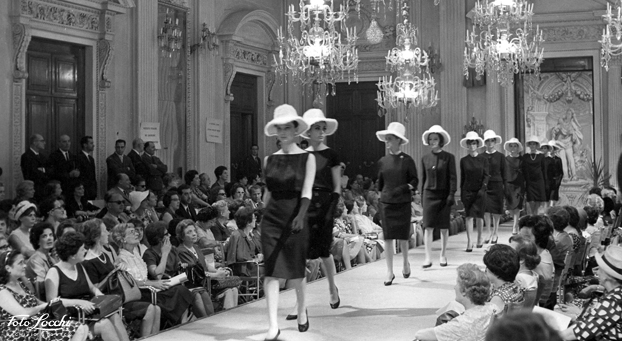Fashion in Florence through the lens of Archivio Foto Locchi
In the Andito of Angiolini Palazzo Pitti, from January 10 to March 5
Cool white. The perfect color in that skirt that moves like a wave of silk and chiffon. A crisp white, limpidly capable of surviving the decades intact. A sophisticated white, light over shoulders and hips, marked by the beauty of a black pattern. And a photo camera. Cumbersome perhaps, with that flash that has to be mounted and monitored so it does not suddenly explode.
A photograph that is already a manifestation of intention, a theory that takes shape and becomes clear. It is a way of creating and illustrating fashion that the mind records and then settles lightly into the barely-perceivable rhythms of beauty, which branches out from Florence and spreads far and wide. Beauty that persists underground then suddenly emerges when the need is most pressing. A promise of future and of light in unexpected yet tenacious dimensions.
First event of the 91st Pitti Immagine, this is what “Fashion in Florence through the lens of Archivio Foto Locchi” is about: 100 rare photographs which tell the story of fashion in Florence from the 1930s to the 1970s through the lens of the photographers of the ‘bottega’ (workshop) Foto Locchi.
A story in black and white which can still tell us a great deal, beginning with the hands of the Florentine craftspeople and their renowned ‘mani d’oro’ (literally golden hands, meaning hands that create wonderful things), and ending with the crisp, impeccable outfits of the Dukes of Windsor, photographed while they stroll along the streets of Florence on a sunny day. A story that will unfold within Palazzo Pitti’s cozy Andito degli Angiolini. The project stems from the fruitful encounter of Eike Schmidt, Uffizi Gallery Director; Andrea Cavicchi, President of the Centro di Firenze per la Moda Italiana; Erika Ghilardi, from the Historical Archive of Foto Locchi; and the publishing house Gruppo Editoriale.
The first photographic exhibition displaying the heritage of the Archivio Foto Locchi, abounding with images that have been cataloged and preserved in a unique way, brings into focus an unfamiliar Florence, to some extent shown for the first time. A city which produced a style that was developing around an inborn ‘fashion system’ consisting of craftspeople possessing time-honored know-how, seamstresses with sharp black eyes and personalities whose names were to become legendary – Salvatore Ferragamo, Emilio Pucci, Gucci, only to mention a few – and who were running newborn fashion houses already popular among lovers of beauty. But there were others who also contributed to the Florentine style in fashion: Elsa Schiaparelli, Emilio Schubert and Roberto Capucci; and of course famous stars such as the eternally-young Audrey Hepburn, the Italian-by-adoption Paulette Goddard and the divine Maria Callas.
And last but not least, Giovan Battista Giorgini, the determined creator of Fashion in Florence, the man with strategic knowledge and indescribable savoir-faire, the gentleman of the Sala Bianca. His were the intuitions that led to a glittering world of elegance and a ‘system’ that has maintained its value. The exhibition has been meticulously curated by Erika Ghilardi and Matteo Parigi Bini of the Gruppo Editoriale.
The former, a descendant of the founders of the Studio Locchi, said of the event to be held at the Andito degli Angiolini, “The family is extremely proud and deeply touched. Fashion is one of the Archive’s most present and significant themes. It is a cultural and visual heritage comprising over five million images that can recount the history of Florence over the past century.”
The exhibition catalog features well-calibrated authorships. There are two presentations, one by Eike Schmidt and the other by Andrea Cavicchi, and texts by Stefania Ricci, (Director of the Salvatore Ferragamo Museum), Caterina Chiarelli (Director of the Costume Gallery of Palazzo Pitti and of the Tapestry Repository of the Medici Collection) and Eva Desiderio (chief-editor of the magazine Moda e Società of the Quotidiano Nazionale) – a refined expert on the style that enlivens Florence.
Open until 5 March, the exhibition is divided into three sections: Le Botteghe Artigiane (the craftshops), La Moda a Firenze (fashion in Florence) and I Personaggi della Moda (the fashion personalities) and is a rare opportunity to discover (through fashion) surprising corners of the city and look at those well-mannered, wide-eyed children modeling bespoke outfits in 1954.









